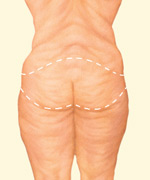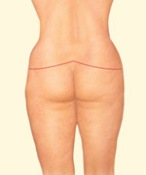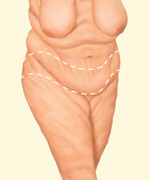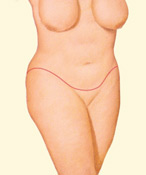LOWER BODY LIFT
A DISTINCTIVELY DIFFERENT PRACTICE
EXPERIENCE EXTRAORDINARY
What is a Lower Body Lift?
Aging, sun damage, pregnancy, significant fluctuations in weight, and genetic factors may contribute to poor tissue elasticity that can result in sagging of the abdomen, buttocks, and thighs. A lower body lift improves the contours of the buttocks and thighs by removing excess sagging skin and fat. Dimpled, irregular skin surfaces, commonly known as cellulite, can also be improved with a lower body lift.
Lower body lifts are not intended strictly for the removal of excess fat. Liposuction alone can remove excess fat deposits where the skin has good elasticity and is able to naturally conform to new body contours. In cases where skin elasticity is poor, a combination of liposuction and lower body lift techniques may be recommended.
The ideal candidates for lower body lift surgery are adults whose primary problem is significant buttock and thigh skin laxity. Weight should be relatively stable and the individual should not be significantly overweight. It is important to remember that the shape and appearance of one’s body are dynamic and can change with fluctuations in weight, pregnancy, menopause, and with aging. Maintaining your weight and keeping a healthy lifestyle will help the longevity of your lower body lift procedure.
Aging, sun damage, pregnancy, significant fluctuations in weight, and genetic factors may contribute to poor tissue elasticity that can result in sagging of the abdomen, buttocks, and thighs. A lower body lift improves the contours of the buttocks and thighs by removing excess sagging skin and fat. Dimpled, irregular skin surfaces, commonly known as cellulite, can also be improved with a lower body lift.
Lower body lifts are not intended strictly for the removal of excess fat. Liposuction alone can remove excess fat deposits where skin has good elasticity and is able to naturally conform to new body contours. In cases where skin elasticity is poor, a combination of liposuction and lower body lift techniques may be recommended.
The ideal candidates for lower body lift surgery are adults whose primary problem is significant buttock and thigh skin laxity. Weight should be relatively stable and the individual should not be significantly overweight. It is important to remember that the shape and appearance of one’s body are dynamic and can change with fluctuations in weight, pregnancy, menopause, and with aging. Maintaining your weight and keeping a healthy lifestyle will help the longevity of your lower body lift procedure.
FAQ’s








